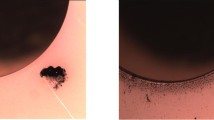Abstract
Since the initial smoke detector was developed, research has been ongoing to reduce the response times to fire sources and improve the ability of detectors to ignore nuisance sources. Research has been conducted to analyze the signatures from cooking activities, ranging from normal cooking to the flaming ignition of food products with the intent of identifying the precursors to flaming ignition. In particular, the goal of the research is to provide an alarm sufficiently prior to flaming ignition to allow homeowners to take corrective actions to prevent a fire. For the 11 experiments analyzed, the optical density measured in the range hood was the most accurate precursor signal, having the greatest ability to predict the imminent transition to a flaming fire with a minimum of false positives. Though plagued by false positives, the temperature of the heating element and response of an ionization detector provided a faster response than the optical density measure. Given that this research only included 11 experiments, further research should be conducted on a broader range of cooking styles and items being cooked.


















Similar content being viewed by others
Notes
CO, CO2 and O2 monitoring was accomplished through paramagnetic analyzers for oxygen and non-dispersive infrared (NDIR) analyzers for CO and CO2.
1 m path length, centered over the middle of the range, as indicated in Figure 1.
Oxygen was measured using a Siemens Oxymat 6 paramagnetic analyzers (0–25% O2, 0.25% repeatability); carbon monoxide and carbon dioxide were measured using Siemens Ultramar 23 non-dispersive infrared (NDIR) analyzers (0–1% carbon monoxide, 0–10% carbon dioxide, 1% range repeatability). Each analyzer was calibrated with a known concentration of gas to determine the appropriate corrections to manufacturer-supplied calibration curves. This correction was less than 1% of the measured value. Test data were shifted to account for these delay times associated with the sampling line lengths, filters, and pumps.
.
References
Meili E (1990) My life with cerberus: successes and setbacks, translation by Peter Hill, Dartmouth/GB, Zürichsee Druckerei Stäfa
Milke JA, Hagen BC, McAvoy TJ, Pan D (1994) Large-scale experiments of fire signatures to develop a discriminating fire detector, NISTIR 5499. National Institute of Standards and Technology, Gaithersburg, MD, September 1994
Milke A (1999) Monitoring multiple aspects of fire signatures for discriminating fire detection. Fire Technol 35(3):195–209, 3rd Quarter
Hagen BC, Milke JA (2000) The Use of Gaseous Fire Signatures as a Mean to Detect Fires. Fire Safety J 34(1):55–67
Milke JA, McAvoy TJ (1995) Analysis of signature patterns for discriminating fire detection with multiple sensors. Fire Technol 31(3):120–136, 2nd Quarter 1995
Gottuk DT, Hill SA, Schemel CF, Strehlen BD, Rose-Pehrsson SL, Shaffer RE, Williams FW, Tatem PA (1999) Identification of fire signatures for shipboard multi-criteria fire detection systems, NRL/MR/6180–99-8386. Naval Research Laboratory, Washington, DC, June 18, 1999
Geiman JA, Gottuk DT, Milke JA (2006) Evaluation of smoke detector response estimation methods: optical density, temperature rise and velocity at alarm. J Fire Prot Eng 16(4)
Su JZ, Crampton GP, Carpenter DW, McCartney C, Leroux P (2003) Kemano fire studies—part 1: response of residential smoke detectors. Research Report, Institute for Research in Construction. National Research Council Canada, p 108
Milke JA, Hulcher ME, Worrell CL, Gottuk DT, Williams FW (2003) Investigation of multi-sensor algorithms for fire detection. Fire Technol 39(4):363–382, 4th Quarter, October 2003
Milke JA, Mowrer FW, Gandhi P (2008) Validation of a smoke detection performance prediction methodology. Fire Protection Research Foundation, Quincy, MA, October 2008
Zevotek R, Milke J, Fabian T (2013) Predictors for the detection of cooktop fires, 2013 suppression, detection and signaling research and applications symposium, Orlando, FL, February 26, 2013
Zevotek R (2014) Identification of precursor signals to impending cooking related fires. M.S. Thesis, Department of Fire Protection Engineering, University of Maryland, College Park
Universal Security Instruments, Inc. (2013) The new IoPhic universal sensing technology from smoke alarms.com. [Online] http://smokealarms.com/iophic.htm, September 3, 2013
Bukowski RW, Peacock RD, Averill JD, Cleary TG, Bryner NP, Walton WD, Reneke PA, Kuligowski ED (2008) Performance of home smoke alarms analysis of the response of several available technologies in residential fire settings. NIST TN 1455. National Institute of Standards and Technology, Gaithersburg, MD, February 2008 Revision
CPSC (1998) Study of technology for detecting pre-ignition conditions of cookng related fire associated with electric and gas ranges: phase III. Consumer Product Safety Commission, Washington, DC
Ansari A, Guarav A, Yadav V (2010) Report of research on detection of kitchen fire. Underwriters Laboratories Inc., Ahmedabad, Gujarat
Author information
Authors and Affiliations
Corresponding author
Rights and permissions
About this article
Cite this article
Milke, J., Zevotek, R. Analysis of the Response of Smoke Detectors to Smoldering Fires and Nuisance Sources. Fire Technol 52, 1235–1253 (2016). https://doi.org/10.1007/s10694-015-0465-2
Received:
Accepted:
Published:
Issue Date:
DOI: https://doi.org/10.1007/s10694-015-0465-2




